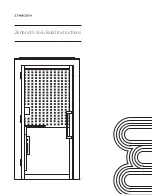
Introducing the MSQ
____________________________________________________________________ The Vacuum System
The Vacuum System
The main challenge in interfacing MS with LC is the introduction of a liquid
mobile phase at flow rates of up to 2.0 mL/min into a system that operates
under vacuum. The transition between atmospheric pressure and high
vacuum is achieved by using several different stages of pressure controlled
by the vacuum system. This arrangement effectively removes the mobile
phase, leaving the analytes to travel as ions through the mass analyzer.
It is important to remember that an MS detector must be under high vacuum
in order to operate. In the case of the MSQ system, not all of the MS
detector is under high vacuum. The ion source is held at atmospheric
pressure, while the region between the entrance and exit cones is held at an
intermediate pressure to step down to the high vacuum region in the mass
analyzer and detector. The intermediate pressure region is pumped by one
rotary pump. The high vacuum in the mass analyzer and detector region is
achieved by using a split-flow turbomolecular pump. All the pumps are
controlled by the data system.
___________________________MSQ Hardware Manual ___________________________
1-27
















































